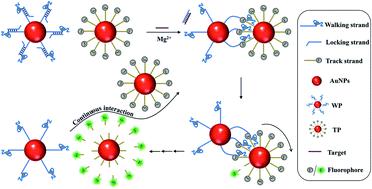当前位置:
X-MOL 学术
›
Chem. Sci.
›
论文详情
Our official English website, www.x-mol.net, welcomes your
feedback! (Note: you will need to create a separate account there.)
An interparticle relatively motional DNA walker and its sensing application
Chemical Science ( IF 7.6 ) Pub Date : 2020-06-30 , DOI: 10.1039/d0sc00109k Hong Zhang 1, 2, 3, 4 , Xiaowen Xu 1, 2, 3, 4 , Wei Jiang 1, 2, 3, 4
Chemical Science ( IF 7.6 ) Pub Date : 2020-06-30 , DOI: 10.1039/d0sc00109k Hong Zhang 1, 2, 3, 4 , Xiaowen Xu 1, 2, 3, 4 , Wei Jiang 1, 2, 3, 4
Affiliation

|
DNA molecular machines are DNA self-assemblies that perform quasi-mechanical movement at the micro–nano scale, and have attracted increasing attention in the fields of biosensing, drug delivery and biocomputing. Herein, we report the concept and operation of an interparticle relatively motional DNA walker. The walker is composed of walking particles (WPs) and track particles (TPs). The WPs and TPs are obtained by respective functionalization of locked walking strands containing DNAzyme sequences and fluorophore-labelled track strands containing substrate sequences onto gold nanoparticles (AuNPs). Triggered by the target that specifically unlocks the walking strand, the liberated walking strands cooperatively hybridize with the track strands. The track strand gets cleaved by the DNAzyme, accompanied by the fluorophore release. The adjacent walking strand on the WP subsequently hybridizes to the next track strand, inducing the relative motion of the WP around the TP. After walking along the surface of one TP, the WP can continue to interact with another TP. As a result of the improved moving freedom and area, the interparticle motional mode induces high continuity and achieves large signal accumulation. Taking Zika virus RNA fragments (ZIKV-RNA) as a model target, the DNA walker shows a high sensitivity with a detection limit of 118 pM, and can reliably detect the target in biological fluids due to the stability of its components. The constructed DNA walker provides a new type of free and robust motion mode between particles and holds potential in clinical diagnosis.
中文翻译:

粒子间相对运动的DNA Walker及其传感应用
DNA分子机器是在微纳米尺度上执行准机械运动的DNA自组装体,在生物传感,药物输送和生物计算领域已引起越来越多的关注。在本文中,我们报告了粒子间相对运动的DNA Walker的概念和操作。步行器由步行粒子(WP)和跟踪粒子(TP)组成。WP和TP通过分别将包含DNAzyme序列的锁定步行链和包含底物序列的荧光团标记的轨道链功能化到金纳米颗粒(AuNPs)上而获得。由专门解锁行走链的目标触发,释放的行走链与履带链协同杂交。轨道链被DNA核酶切割,并伴随着荧光团的释放。WP上相邻的行走链随后与下一个履带链杂交,从而引起WP绕TP的相对运动。沿着一个TP的表面行走之后,WP可以继续与另一个TP交互。由于改善了移动自由度和面积,粒子间运动模式引起了较高的连续性并实现了较大的信号累积。以Zika病毒RNA片段(ZIKV-RNA)为模型目标,DNA Walker显示了高灵敏度,检测限为118 pM,并且由于其成分的稳定性,可以可靠地在生物体液中检测目标。构造的DNA Walker提供了一种新型的粒子间自由而强大的运动模式,并在临床诊断中具有潜力。引起WP在TP周围的相对运动。沿着一个TP的表面行走之后,WP可以继续与另一个TP交互。由于改善了移动自由度和面积,粒子间运动模式引起了较高的连续性并实现了较大的信号累积。以Zika病毒RNA片段(ZIKV-RNA)为模型目标,DNA Walker显示了高灵敏度,检测限为118 pM,并且由于其成分的稳定性,可以可靠地在生物体液中检测目标。构造的DNA Walker提供了一种新型的粒子间自由而强大的运动模式,并在临床诊断中具有潜力。引起WP在TP周围的相对运动。沿着一个TP的表面行走之后,WP可以继续与另一个TP交互。由于改善了移动自由度和面积,粒子间运动模式引起了较高的连续性并实现了较大的信号累积。以Zika病毒RNA片段(ZIKV-RNA)为模型目标,DNA Walker显示了高灵敏度,检测限为118 pM,并且由于其成分的稳定性,可以可靠地在生物体液中检测目标。构造的DNA Walker提供了一种新型的粒子间自由而强大的运动模式,并在临床诊断中具有潜力。粒子间运动模式引起高连续性并实现大信号积累。以Zika病毒RNA片段(ZIKV-RNA)为模型目标,DNA Walker显示了高灵敏度,检测限为118 pM,并且由于其成分的稳定性,可以可靠地在生物体液中检测目标。构造的DNA Walker提供了一种新型的粒子间自由而强大的运动模式,并在临床诊断中具有潜力。粒子间运动模式引起高连续性并实现大信号积累。以Zika病毒RNA片段(ZIKV-RNA)为模型目标,DNA Walker显示了高灵敏度,检测限为118 pM,并且由于其成分的稳定性,可以可靠地在生物体液中检测目标。构造的DNA Walker提供了一种新型的微粒间自由而稳定的运动模式,并在临床诊断中具有潜力。
更新日期:2020-07-22
中文翻译:

粒子间相对运动的DNA Walker及其传感应用
DNA分子机器是在微纳米尺度上执行准机械运动的DNA自组装体,在生物传感,药物输送和生物计算领域已引起越来越多的关注。在本文中,我们报告了粒子间相对运动的DNA Walker的概念和操作。步行器由步行粒子(WP)和跟踪粒子(TP)组成。WP和TP通过分别将包含DNAzyme序列的锁定步行链和包含底物序列的荧光团标记的轨道链功能化到金纳米颗粒(AuNPs)上而获得。由专门解锁行走链的目标触发,释放的行走链与履带链协同杂交。轨道链被DNA核酶切割,并伴随着荧光团的释放。WP上相邻的行走链随后与下一个履带链杂交,从而引起WP绕TP的相对运动。沿着一个TP的表面行走之后,WP可以继续与另一个TP交互。由于改善了移动自由度和面积,粒子间运动模式引起了较高的连续性并实现了较大的信号累积。以Zika病毒RNA片段(ZIKV-RNA)为模型目标,DNA Walker显示了高灵敏度,检测限为118 pM,并且由于其成分的稳定性,可以可靠地在生物体液中检测目标。构造的DNA Walker提供了一种新型的粒子间自由而强大的运动模式,并在临床诊断中具有潜力。引起WP在TP周围的相对运动。沿着一个TP的表面行走之后,WP可以继续与另一个TP交互。由于改善了移动自由度和面积,粒子间运动模式引起了较高的连续性并实现了较大的信号累积。以Zika病毒RNA片段(ZIKV-RNA)为模型目标,DNA Walker显示了高灵敏度,检测限为118 pM,并且由于其成分的稳定性,可以可靠地在生物体液中检测目标。构造的DNA Walker提供了一种新型的粒子间自由而强大的运动模式,并在临床诊断中具有潜力。引起WP在TP周围的相对运动。沿着一个TP的表面行走之后,WP可以继续与另一个TP交互。由于改善了移动自由度和面积,粒子间运动模式引起了较高的连续性并实现了较大的信号累积。以Zika病毒RNA片段(ZIKV-RNA)为模型目标,DNA Walker显示了高灵敏度,检测限为118 pM,并且由于其成分的稳定性,可以可靠地在生物体液中检测目标。构造的DNA Walker提供了一种新型的粒子间自由而强大的运动模式,并在临床诊断中具有潜力。粒子间运动模式引起高连续性并实现大信号积累。以Zika病毒RNA片段(ZIKV-RNA)为模型目标,DNA Walker显示了高灵敏度,检测限为118 pM,并且由于其成分的稳定性,可以可靠地在生物体液中检测目标。构造的DNA Walker提供了一种新型的粒子间自由而强大的运动模式,并在临床诊断中具有潜力。粒子间运动模式引起高连续性并实现大信号积累。以Zika病毒RNA片段(ZIKV-RNA)为模型目标,DNA Walker显示了高灵敏度,检测限为118 pM,并且由于其成分的稳定性,可以可靠地在生物体液中检测目标。构造的DNA Walker提供了一种新型的微粒间自由而稳定的运动模式,并在临床诊断中具有潜力。











































 京公网安备 11010802027423号
京公网安备 11010802027423号